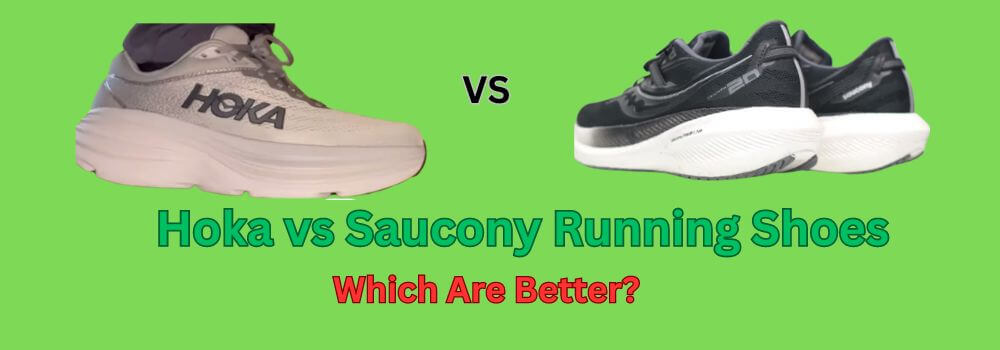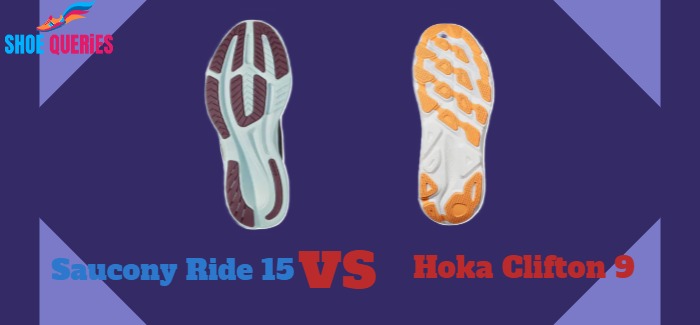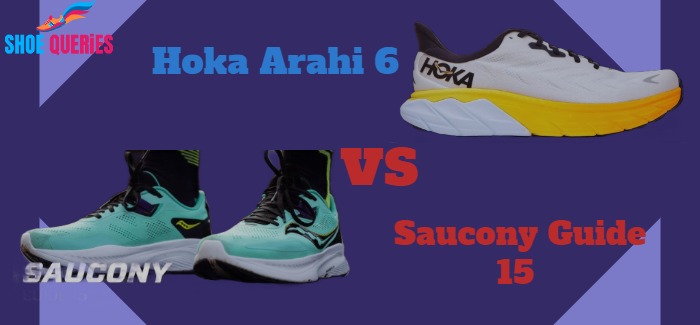Running shoes are more than just fancy foot coverings; they are your faithful companions on the track or trail. But with so many brands out there, it can be challenging to decide which pair will help you cross the finish line with a smile.

In this Hoka vs Saucony showdown, we’ll explore the key differences, designs, and popular models of these two well-loved running shoe brands. We’ll even add a dash of humor to keep you entertained along the way. So, let’s tie those laces and dive right in!
Quick Answer:
If you’re in a hurry, we’ve got your back! Hoka and Saucony both offer exceptional running shoes, but they cater to slightly different needs. Hoka shoes are known for their pillowy cushioning, which is great for long-distance runs and comfort seekers. On the other hand, Saucony shoes excel in providing stability, making them a favorite among those with pronation issues.
But remember, it all boils down to your unique preferences and running style. So, whether you’re Team Hoka or Team Saucony, you’re bound to find a perfect fit. Let’s explore the differences in detail!
Hoka Vs Saucony Key Differences:
First, let’s break down the main distinctions between Hoka and Saucony running shoes.
Hoka Running Shoes:
Cloud-Like Cushioning: Hoka shoes are renowned for their plush cushioning, offering a smooth and comfortable ride.
Lightweight Design: Despite the generous cushioning, Hoka manages to keep their shoes surprisingly light, perfect for those looking to fly.
Unique Rocker Geometry: Hoka shoes often feature a rocker sole that promotes a natural gait cycle, reducing fatigue on long runs.
Saucony Running Shoes:
Stability Focus: Saucony shoes prioritize stability, making them a top choice for runners with pronation issues.
Traditional Design: Saucony maintains a more traditional shoe design, catering to those who prefer a classic look.
Diverse Options: Saucony offers a wide range of models, from minimalistic to heavily cushioned, allowing you to find your ideal match.
How Do You Say Saucony?
Before we dive deeper into the features and designs, let’s address the age-old question: how on Earth do you pronounce “Saucony”? It’s “sock-uh-knee.” But don’t worry if you’ve been saying it differently; it’s one of those running mysteries that you’re now privy to.
Saucony vs HOKA ONE ONE Feature Comparison:
Now let’s get into the specifics that really matter for your run.
Durability:
Although Hoka shoes are renowned for their cushioning, their added softness may cause wear and tear to occur more quickly. Saucony, with its focus on stability, tends to offer more durable options for the long run.
Shoe Fit:
Hoka’s wide toe box and comfortable interiors are perfect for those seeking a relaxed fit. Saucony, however, provides options for all foot types, from narrow to wide, ensuring a snug fit for everyone.
Cushioning:
Hoka’s plush cushioning is like running on a cloud, perfect for those long training sessions. Saucony, while offering cushioning, focuses more on support and stability.
Stability:
If you’re looking for stability, Saucony is your friend. Its technology helps with overpronation and keeps your feet in check. Hoka, with its rocker geometry, offers a different approach to maintaining stability through a natural gait.
Affordability:
When it comes to affordability, Saucony generally has a slight edge. Their wide range of models includes budget-friendly options, making quality running shoes accessible to many.
Saucony vs Hoka Design Comparison:
Looks matter too! Let’s compare their designs.
Upper:
Hoka shoes often have eye-catching and futuristic designs, reflecting their focus on innovation. Saucony maintains a more traditional look with a wide array of color options.
Midsole:
Hoka shoes have thicker midsoles, showcasing their dedication to cushioning. Saucony, while cushioned, maintains a sleeker profile.
Outsole:
Saucony’s outsoles are often flatter and broader, providing stability. Hoka’s outsoles are more curved to promote a smoother transition during your runs.
Saucony vs Hoka Popular Shoe Comparison:
Let’s put some popular models head-to-head.
Ultimate Comfort Showdown: Saucony Ride 15 vs. Hoka Clifton 9
Are you ready to revolutionise your running experience? Introducing the ultimate comfort showdown: the Saucony Ride 15 vs. the Hoka Clifton 9.

Elevate Your Run with Saucony Ride 15:
Unleash the power of the Saucony Ride 15, a pinnacle of running innovation. With its cutting-edge technology and design, the Ride 15 promises an extraordinary journey with every stride. Engineered for excellence, this running shoe offers:
✅ Responsive Cushioning: Enjoy a plush, yet responsive, underfoot experience, keeping you comfortable even on the longest runs.
✅ Precision Fit: The Ride 15 features a tailored fit that locks your foot in place, preventing discomfort and blisters.
✅ Lightweight Design: Experience the joy of feather-light running shoes that make you feel like you’re floating on air.
✅ Superior Traction: Conquer any terrain with confidence, thanks to the Ride 15’s outstanding grip.
Step into Cloud-Like Bliss with Hoka Clifton 9:
The Hoka Clifton 9 redefines the meaning of comfort. Slip into these extraordinary running shoes and experience the sensation of running on clouds. Here’s why the Clifton 9 is a game-changer:
✅ Maximum Cushioning: Indulge your feet with the plush cushioning that absorbs impact, reducing stress on your joints.
✅ Effortless Strides: The Clifton 9’s lightweight structure ensures every step is effortless, letting you go the distance without fatigue.
✅ Breathable Design: Stay cool and dry throughout your run with the Clifton 9’s superior breathability.
✅ Durability: These shoes are built to last, so you can keep enjoying the heavenly comfort for miles to come.
The Choice is Yours:
When it comes to the Saucony Ride 15 vs. Hoka Clifton 9, you’re spoiled for choice. Two comfort titans with unique qualities. So whose side are you on?
Elevate your run with Saucony’s precision engineering, or step into the world of cloud-like bliss with Hoka’s superior cushioning. The decision is yours, but one thing is certain – your running experience will never be the same again. Buy online today and discover the difference!
Saucony Kinvara 13 vs Hoka Rocket X2:
Today, I’m pleased to discuss two outstanding running shoes: the Saucony Kinvara 13 and the Hoka Rocket X2. In this review, I’ll get into the details and present a thorough comparison to help you make an informed selection.
Saucony Kinvara 13:
A superior running shoe for those who value quickness, responsiveness, and a featherweight feel is the Saucony Kinvara 13. Speed and agility runners will love this 7.5-ounce men’s size 9 shoe, one of the lightest in its class.
The 8mm heel-to-toe drop shoe is the right balance of comfort and ground feel. Saucony’s PWRRUN foam, which provides a quick and springy feel underfoot, provides the cushioning.
Hoka Rocket X2:
On the other hand, the Hoka Rocket X2 is a stellar competitor in the running shoe market. It’s for racers looking to beat their opponents. Don’t let this shoe’s 7.8-ounce weight for a men’s size 9 stop you.
With a heel-to-toe drop of 5 mm, it’s a low-profile choice for individuals who want simpler styles. The cushioning is distinct in the Rocket X2, thanks to Hoka’s CMEVA foam, offering excellent energy return.
Key Decision-Making Factors:
When choosing between these two exceptional running shoes, several key factors come into play. The first is your running style and preference.
The Saucony Kinvara 13 is ideal for runners who like lightweight, cushioned shoes with an 8mm drop. It’s perfect for long-distance running and daily training due to its comfort and speed.
If you’re a professional racer or prefer a minimalist design with a smaller heel-to-toe drop, choose the Hoka Rocket X2. It excels in short-distance races and offers a more responsive feel underfoot.
In Summary, both the Saucony Kinvara 13 and Hoka Rocket X2 are fantastic running shoes, but they cater to slightly different niches within the running community. Your choice ultimately depends on your running goals and preferences.
Saucony Guide 15 vs Hoka Arahi 6

The key to selecting the optimal running shoe is striking the right mix between performance, support, and comfort. The Saucony Guide 15 and the Hoka Arahi 6 are two well-liked choices in the running shoe market.
Support and Stability:
Saucony Guide 15: The Saucony Guide 15 is known for its stability and support, making it a good choice for runners who overpronate. It features the brand’s PWRRUN cushioning for comfort and support.
Hoka Arahi 6: The Hoka Arahi 6 is designed with stability in mind, featuring J-Frame technology. This is a lightweight, supportive foam that helps reduce overpronation while providing cushioning.
Cushioning:
Saucony Guide 15: This shoe offers a responsive yet cushioned ride due to the PWRRUN midsole, which provides energy return and impact absorption.
Hoka Arahi 6: Hoka shoes are known for their maximal cushioning. The Arahi 6 utilizes a plush EVA midsole and a supportive J-Frame technology, which provides a comfortable and cushioned feel.
Weight:
Saucony Guide 15: It is relatively lightweight for a stability shoe, making it suitable for various types of runs.
Hoka Arahi 6: The Arahi 6 is a typical Hoka sneaker, weighing a little bit more thanks to the additional padding. Although it’s not the lightest choice, it provides excellent support and cushioning.
Drop:
Saucony Guide 15: It typically has a 8mm drop, which is considered a moderate drop, suitable for many runners.
Hoka Arahi 6: Hoka shoes often have a higher drop, and the Arahi 6 is no different with a 5mm drop. Some runners prefer lower drops for a more natural feel, while others may need the higher drop for added support.
Fit and Comfort:
Both shoes offer comfortable fits, but it’s essential to try them on to determine which one suits your foot shape and size better.
Price:
While selecting running shoes, cost can be an important consideration. Given the range of pricing points offered by both brands, you might find one to be more affordable than the other.
Ultimately, your choice between the Saucony Guide 15 and the Hoka Arahi 6 should depend on your specific needs, running style, and comfort preferences. It’s recommended to try them on and run in them to see which one feels better on your feet.
Additionally, consulting with a professional at a running store can help you make an informed decision based on your individual gait and needs.
Saucony Triumph 20 vs Hoka Bondi 8:
When it comes to choosing the perfect running shoe, the options are seemingly endless. Two of the most renowned contenders in the market, the Saucony Triumph 20 and the Hoka Bondi 8, have captivated the attention of runners worldwide.
Saucony Triumph 20
The Saucony Triumph 20 is a versatile running shoe suitable for various terrains. The lightweight construction and well-cushioned midsole make it ideal for daily training. Whether you’re hitting the pavement or exploring trails, these shoes provide the support and comfort you need.
The FORMFIT technology adapts to your feet, reducing the risk of blisters or discomfort. With an 8mm offset, they strike a balance between cushioning and responsiveness, making them a reliable choice for runners of all levels.
Product Information
- Weight: Approximately 10.7 ounces
- Heel-to-Toe Drop: 8mm
- Upper Material: Synthetic and mesh
- Outsole Material: Rubber
- Closure: Lace-up
Hoka Bondi 8
The Hoka Bondi 8 is all about cushioning. It’s perfect for those who demand a cloud-like experience while running. EVA midsole and Meta-Rocker technology enhance natural gait.
These shoes are ideal for runners with joint concerns or who run long distances due to their superior shock absorption. The designed mesh upper keeps feet cool and dry during running.
Product Information
- Weight: Approximately 10.1 ounces
- Heel-to-Toe Drop: 4mm
- Upper Material: Engineered mesh
- Outsole Material: Rubber
- Closure: Lace-up
Final Discussion: Hoka vs Saucony Running Shoes:
Ultimately, the choice between Hoka and Saucony running shoes boils down to your unique preferences and running style. If you’re seeking cloud-like cushioning and a more futuristic design, Hoka might be your brand. However, Saucony is the best option if you want stability and a traditional appearance.
Frequently Asked Questions:

A K M Azad, The Founder of Shoe Queries, In 2023, I set out on a remarkable journey into the world of footwear, driven by an unwavering passion for shoes. His enthusiasm for renowned brands such as Nike, Birkenstocks, Hey Dudes, Crocs, Vans, Uggs, Converse, New Balance, and many others fueled his dedication to disseminating in-depth research on a wide array of footwear styles.
